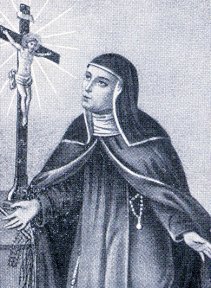Maria Llorença Llong facts for kids
Quick facts for kids BlessedMaria Llorença Requenses Llong |
|
|---|---|

Print from the 18th century.
|
|
| Religious | |
| Born | 1463 Lleida, Crown of Aragon |
| Died | 21 December 1539 (aged 76) Naples, Kingdom of Naples |
| Venerated in | Roman Catholic Church |
| Beatified | 9 October 2021, Cathedral of Santa Maria Assunta, Naples, Italy by Cardinal Marcello Semeraro |
| Feast | 21 October |
| Attributes | Religious habit |
| Patronage | Capuchin Poor Clares Ospedale degli Incurabili |
Maria Llorença Requenses Llong (also known as Maria Lorenza Longo in Italian) was born in 1463. She was a Spanish Catholic nun. She founded a group of nuns called the Capuchin Poor Clares.
Maria also started a hospital in Naples called "Santa Maria del Popolo". She moved to Naples after her husband died. Important church leaders like Pope Leo X and Pope Adrian VI gave special support to her hospital.
Maria Llorença Llong was given the title Servant of God in 1892. This was the first step towards becoming a saint. Later, Pope Francis called her Venerable in 2017 because of her great goodness. In 2020, the Pope approved a miracle that happened because of her. This allowed her to be beatified (declared "Blessed"). Her beatification ceremony took place in Naples on October 9, 2021.
Contents
Her Life Story
Maria Llorença Llong was born in Lleida, Spain, around 1463. Her family was noble. In 1506, she moved to Naples with her husband, Juan Llong. At that time, Maria was paralyzed.
Her husband passed away in 1509. Maria was left with her three children. She then went on a special trip, called a pilgrimage, to Loreto. There, she said she was cured of her paralysis. She believed this healing was thanks to the Blessed Virgin Mary.
Starting a Hospital and Convent
In 1519, Maria started the Santa Maria del Popolo hospital. She had a vision that told her to create a women's convent. This convent was named "Santa Maria in Gerasalamme".
Maria wanted her new group of nuns to live simply and humbly. They would follow the strict rules of Francis of Assisi and Clare of Assisi. This idea was similar to how Matteo da Bascio had started the Capuchin monks.
The Capuchin Poor Clares
Maria's new group of nuns got help from the Capuchin monks. They became known as the Capuchin Poor Clares. The nuns wore clothes similar to the monks. They had a simple brown tunic with a cord around the waist. They also wore a short cape. The nuns added a wimple (a cloth covering the neck and chin) and a black veil.
During Maria's life, many women joined her order. They also received money from kind women who wanted to help. Maria's idea was to bring back the original simple ways of Clare of Assisi. In 1533, she chose Gaetano dei Conti di Thiene as her spiritual guide.
Maria wanted the Pope to approve her convent. Pope Paul III gave his approval on February 19, 1535. The official founding happened on December 10, 1538. Her hospital also received special support from Pope Leo X and Pope Adrian VI. Gian Pietro Carafa, who later became Pope Paul IV, also helped the hospital.
Maria Llorença Llong died in Naples on December 21, 1539. In 1935, her remains were moved. Only her skull was found, and it was placed in an urn in her convent.
Becoming a Blessed Saint
The process to declare Maria a saint began in Naples. This first step happened between 1880 and 1883. Church experts checked all her writings. They approved them in 1890, saying they were correct.
The official process started on September 4, 1892, under Pope Leo XIII. Maria was then called a Servant of God. The process continued for many years. On June 12, 2004, a request was made to restart the cause. It was officially reopened on November 30, 2005.
In 2015, a special report about Maria's life was given to the church. Historians and theologians approved it. On October 9, 2017, Pope Francis said Maria had lived a life of great goodness. He then called her Venerable.
Later, on October 27, 2020, Pope Francis approved a miracle linked to Maria. This meant she could be beatified. Her beatification ceremony was held in Naples on October 9, 2021. Cardinal Marcello Semeraro led the ceremony for the Pope. Cardinal Celestino Aós Braco and Archbishop Domenico Battaglia were also there.
A Reported Miracle
On March 8, 2005, information was found about a possible miracle. It described how Maria Cherubina Pirro was cured of serious tuberculosis. This happened on October 15, 1881, after she visited Maria Llong's remains.
See also


